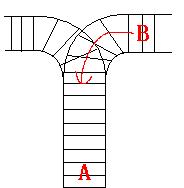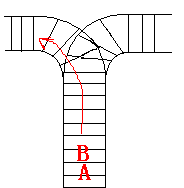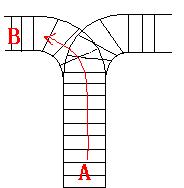Train Problem I
Time Limit: 2000/1000 MS (Java/Others) Memory Limit: 65536/32768 K (Java/Others)Total Submission(s): 41471 Accepted Submission(s): 15510
Problem Description
As the new term comes, the Ignatius Train Station is very busy nowadays. A lot of student want to get back to school by train(because the trains in the Ignatius Train Station is the fastest all over the world ^v^). But here
comes a problem, there is only one railway where all the trains stop. So all the trains come in from one side and get out from the other side. For this problem, if train A gets into the railway first, and then train B gets into the railway before train A leaves,
train A can't leave until train B leaves. The pictures below figure out the problem. Now the problem for you is, there are at most 9 trains in the station, all the trains has an ID(numbered from 1 to n), the trains get into the railway in an order O1, your
task is to determine whether the trains can get out in an order O2.






Input
The input contains several test cases. Each test case consists of an integer, the number of trains, and two strings, the order of the trains come in:O1, and the order of the trains leave:O2. The input is terminated by the
end of file. More details in the Sample Input.
Output
The output contains a string "No." if you can't exchange O2 to O1, or you should output a line contains "Yes.", and then output your way in exchanging the order(you should output "in" for a train getting into the railway,
and "out" for a train getting out of the railway). Print a line contains "FINISH" after each test case. More details in the Sample Output.
Sample Input
3 123 321 3 123 312
Sample Output
Yes. in in in out out out FINISH No. FINISH
通过火车进站前的顺序判断是否能改变为所给的顺序,火车需先进站然后再出站,可用STL中的stack实现,这里用数组模拟压栈
#include<stdio.h>
#include<string.h>
int main()
{
int n;
char s1[20]={0},s2[20]={0},s3[20];
int s1_in[20],s2_in[20];
while(~scanf("%d %s %s",&n,s1,s2))
{
memset(s3,0,sizeof(s3));//需对数组进行清空
int s[20]={0};
int i1=0,i2=0,i3=0,i=0;
//scanf("%s" "%s",s1,s2);
for(i1=0;i1<n;i1++)//将字符转换为数字
{
s1_in[20]=s1[i]-'0';
s2_in[20]=s2[i]-'0';
}
for(i1=0;i1<n;i1++)
{
s3[i3]=s1[i1];//火车进站
i3++;
i++;
while(s3[i3-1]==s2[i2]&&i2<n)
{
i3--;
s[i]=1;
i2++;
i++;
}
}
//printf("%d %d %d %d\n",i1,i2,i3,i);
if(i2==n)//火车全部出站
{
printf("Yes.\n");
for(i1=0;i1<i;i1++)
{
if(s[i1]==1)
{
printf("out\n");
}
else
printf("in\n");
}
printf("FINISH\n");
}
else
{
printf("No.\n");
printf("FINISH\n");
}
}
return 0;
}
 火车调度算法解析
火车调度算法解析





 本文介绍了一个火车调度问题,探讨了如何使用数组模拟栈来验证一组火车能否按照特定顺序离开车站。通过具体的输入输出示例,文章详细展示了算法的实现过程。
本文介绍了一个火车调度问题,探讨了如何使用数组模拟栈来验证一组火车能否按照特定顺序离开车站。通过具体的输入输出示例,文章详细展示了算法的实现过程。
















 500
500

 被折叠的 条评论
为什么被折叠?
被折叠的 条评论
为什么被折叠?








